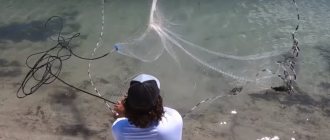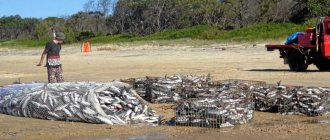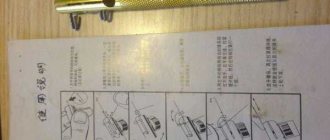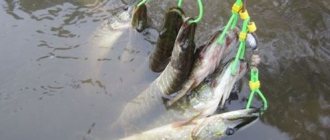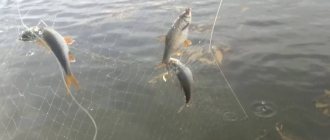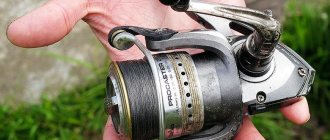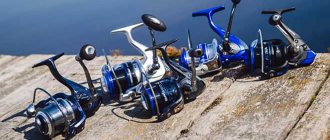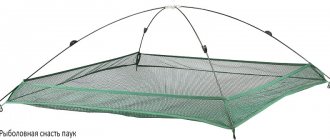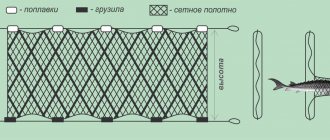The operating principle of a casting net, which is also called a cape, mantle or parachute, is simple. Such fishing gear is wound around the hand and then thrown to the selected point. Then the net is evenly lowered to the bottom, and then rises to the surface. All fish that were in the coverage area of the cape at the time of casting become prey for the angler.
If you observe an experienced fisherman, it seems that there is nothing difficult in casting such a fishing gear. In fact, it can take weeks and months to master the casting network. It is not for nothing that the Japanese treat the casting technique as an art and organize special competitions for masters of this craft.
At the same time, there is nothing overly complicated in handling such a net, and if desired, anyone can learn to fish with this tool in a very short time. There are two types of casting networks - Spanish and American. They differ both in design and casting technique.
American type networks with ring
American networks are equipped with rings of various diameters. Unlike Spanish women, the main cord in such models is attached not to the central part of the mesh, but to the strands, so the technique of working with them is significantly different. Their advantage is the ease of casting - the fisherman just needs to pick up and throw the net at the desired point. Also, American-type models provide more impressive catches than Spanish ones.
When the net is pulled out, the load is pulled to its center, while the entire structure is assembled into a single whole - into a kind of seine with a closed exit.
With a big ring
American nets with a large ring with a diameter of half a meter (Frisbee) can be easily thrown from a boat by throwing it away from you, while the parachute fully opens and completely sinks to the bottom. Models of this type are equipped with three rows of rings .
To cast such a net, you must:
- spread it out on the ground;
- release the middle ring, after which the large ring falls to the lower cord, and the third ring presses the net;
- put a cuff on your wrist;
- unwind the cord and send the net into the water in a motion similar to launching a frisbee.
No special skill or body rotation is required at the moment of the throw. The American net with a large ring is guaranteed to open in the air , while tangling of the lines during the casting process is excluded.
After each cast, the net must be cleared of branches and grass; this rule should not be forgotten even in the heat of excitement of fishing. Such careful attention to the fishing process will minimize the likelihood of unpleasant incidents when the net does not unfold as it should, and the throw is unsuccessful, and all potential prey is scared away in vain.
With small ring
The American casting network with a small ring resembles a Spanish woman. It is well suited for fishing in strong wind conditions, including at sea, when gusts make it difficult to throw a Frisbee net. A small ring presses the bag against the cord while pulling.
It must be borne in mind that the possibility of fishing with a net with a small ring of one diameter or another depends on the height of the fisherman:
- with a height of 1 m 45 cm, you can cast a net with a diameter of up to 3 m;
- height 1 m 70 cm allows you to throw nets with a diameter of 3.5 m;
- with a height of 1 m 80 cm and above, you can fish with four-meter nets.
This is how nets of this type differ from American ones, when fishing with which the diameter of the net used does not depend on height.
Years of training
If you watch several videos on the Internet or on TV of professionals casting a casting net, then at first glance it may seem that it is quite easy to make a good cast with it, but this is not so.
Not every beginner succeeds in performing even a simple casting net the first time. As for master casting, the technique for it has been developed over the years and is based mainly on extensive experience in fishing with this tackle.

The principle of operation of such a net is simple: after casting, due to the sinkers, it moves towards the bottom of the reservoir, and after the fisherman begins to pull the cord towards himself, the net collapses, and the fish in it can no longer get out.
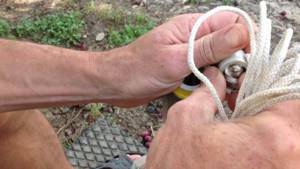
Before going fishing, a beginner should practice throwing this type of gear on solid ground.
It is important not only to observe the angle of the throw and the correct rotation of the body in the right direction, but also to calculate the power of the throw, maintain balance and remember to aim in the right direction.
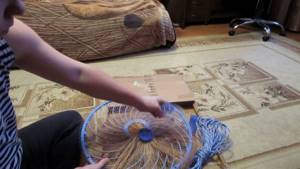
Before casting it is worth:
- Twist the traction cord in rings on the palm of your left hand
- Straighten the net and prevent it from tangling before casting
- Grasp the cord in two places far from each other to ensure maximum straightening of the network.
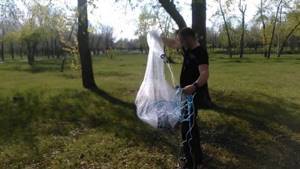
To prevent the loop of the tackle from slipping out of your hands when throwing, there is a little trick: tie the loop around your belt.
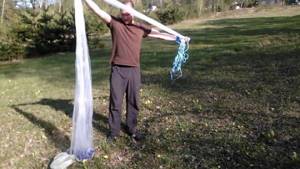
You can throw the net either with one sharp and confident cast, or by “trying it on” for a long time and swaying in place. Each experienced fisherman has his own fishing technique, and in this case it is better for a beginner to find his own.
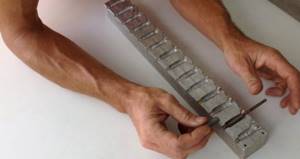
Spanish casting technique
Nets of this type are more difficult to cast, but their important advantage is that they are less likely to get snagged in areas with complex bottom topography.
When pulling a Spanish-type net, the loads converge towards the center of the circle due to their own gravity. To throw it, you need to:
- collect the main (traction) cord in your left hand with rings, check if there are any loops on it;
- take the net by the central part, shake it, stretching and straightening it;
- grab the top of the net with your right hand - about a third of its length - and collect it in one or two loops in your left hand;
- take the weight cord with your right and left hands at two points, spread your arms wide, stretching the net as much as possible;
- turn the body 180 degrees, and then straighten it, simultaneously throwing the net in an arc into the water.
To prevent the entire traction cord from flying into the water after being thrown, the loop at its end must either be secured to the left hand or attached to the belt. The second option is more reliable and completely eliminates the risk of losing gear.
Before going out onto a pond with a net, it is better to practice on land , choosing an area free from thickets of grass and bushes.
At the same time, you can master the technique of folding the net before casting, as well as the casting itself.
Casting technique with casting tackle. A little personal experience.
Today there are many spinning anglers who want to put aside the meat grinder tackle and pick up a casting rod equipped with a multiplier reel. But delving into the details of casting gear, this desire sharply fades, since there are a number of problems that all beginners, without exception, will have to face. And I wouldn’t even call these details problematic, since if you really want to, they can be solved very easily. You just need to put in a little effort and patience. One such issue that really stops many from making the switch is casting technique.
In this article I want to look at two of the simplest casting techniques that I personally have already mastered. This is a side cast and a cast from behind. There is also a pendulum casting technique, flipping and pitching, but more on that later, in separate articles. In the meantime, our goal is to learn the simplest casting and understand the very essence of casting technique.
Adjusting the multiplier reel brakes.
In order to cast without a beard, you first need to correctly adjust the brake units of the multiplier reel. The first unit is the main coil brake, which can be magnetic or centrifugal. Responsible for accelerating the reel spool at the time of casting. Its main function is to prevent the reel spool from accelerating and jumping. The second brake unit is the center brake, it is responsible for the timely stopping of the spool during the splashdown of the bait, thereby helping to avoid the appearance of a beard after the bait has splashed down. The main brake of a baitcasting reel is set to 2/3 of the braking force acting on the reel spool when casting bait or equipment. In my case, this is a reel equipped with a magnetic braking unit, with adjustment from 0 to 27, I set the braking force to 16 - 18. Using the axial brake of the baitcasting reel, we remove the spool play and set it so that when the bait touches freely rotate ground, the braked spool of the multiplier made 0.5 - 1.5 turns and stopped.
main brake interaxial brake of the multiplier reel. multiplier reel.
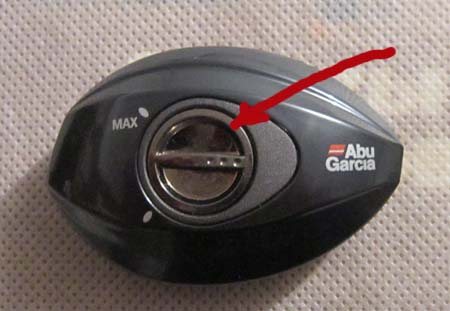
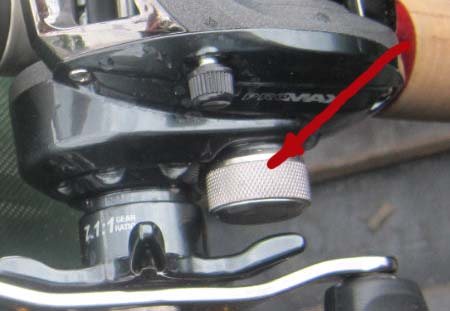
Casting technique with casting tackle.
And so the basic settings are made, let’s move on directly to the casting itself. At the initial stage, I recommend starting with a side cast. As a rule, it starts to work out right away, and for most beginners. The main difference between the casting technique with casting tackle and the meat grinder is the smoothness of the cast, that is, the cast should be fast, but not harsh. It is better to choose a bait with good aerodynamic properties, a spinner or a twister on a jig head. The optimal weight of the bait should be at least 2/3 of the rod's weight, that is, having rods with a weight of up to 21g, we take a bait weighing 14-15g. After the side cast has become successful, we move on to mastering the technique of casting from behind the back. For most beginners, this cast often doesn’t work out right away and raises practically the same question. Why does a side cast, when using the same bait, turn out smooth and without dashing, but when casting from behind, almost 50-70% are accompanied by beards? The main reason for such troubles, as a rule, is the casting technique itself, which is not yet fully understood and has not been worked out to perfection.
When mastering casting from behind the back, the first action that needs to be felt and practiced is swinging the rod and releasing the bait. At the very beginning of casting, you need to load the rod as much as possible and set the starting speed to accelerate the reel spool. Throughout the cast, the swing speed should gradually decrease. At the moment when the rod is at an angle of 60-70 relative to the earth's surface, we release the reel spool from the thumb. As soon as this combination starts working, you can begin practicing faster, power casts designed for distance. If during casting, at the initial stage, there is a rush, you should add braking force on the main brake of the reel. If the beard pops up after splashing down the bait, tighten the center brake. Also, do not forget about your thumb, at the moment of splashing down the bait, you can use it to stop the reel spool.
Another recommendation would be to choose a braided cord. For beginners, I would recommend purchasing a cord that is marked. In the future, when improving your casting range, this will help you quickly and accurately determine the distance to which your bait flies, rather than counting the reel revolutions and making mathematical calculations.
Share on social media networks
To My World
Tweet
RќСЂР°РІРёС‚СЃСЏ
Read similar posts:
Casting rods, or how I made my choice.
Rod Major Craft Corkish SKS662M
Choosing a budget light-class baitcasting reel (soap box).
Multiplier reels.
Choosing a braided cord for a soap dish.
A few details - Shimano Scorpion XT 1001
Casting net fishing tactics
To always have a good catch, it is not enough to master the casting technique. The nuances of fishing with a casting net are no less than with a float rod or donka. For such fishing, areas of reservoirs with an open bottom, free of vegetation and snags, are suitable. It is inconvenient to use a casting net at great depths and fast currents, and it is better to avoid such points.
Achieving a good catch with this gear is not easy - only a person far from fishing would think that it is enough to throw it into a river or lake to get a good trophy, or even several. In reality, the chances of there being good fish in the netted area are slim.
The cape allows you to quickly and easily catch fry for use as live bait. A net with a small mesh, cast in places where small fish accumulate, will bring good catches with each throw.
To get a more substantial trophy, you need to comb with a cape the points where large fish can be held. Since fishing with a casting net among snags is impossible, it is necessary to check areas with uneven bottoms - holes and edges.
Fishing with bait
Good results when fishing with a cape can be achieved using bait . You can select several suitable areas on the reservoir and throw food into them for the fish, and then periodically check them with a net, each time adding a fresh portion of food. This tactic increases the chances of success significantly, because it eliminates the need to throw the net blindly at a point chosen at random.
But there is one difficulty - a very accurate throw is necessary, because a net with a diameter of several meters must accurately cover the baited area. To ensure that the cast hits the target exactly, you can mark the baited points with small buoys , which will serve as landmarks when casting. Without them, the chances of putting the tackle on a small feeding table are slim.
For beginners, the rules for handling the casting network often seem complicated, but, as in any business, skill is gained with practice. Many people disdain fishing with a net, but fishing with a cape can hardly be called unsportsmanlike. It involves an active search for fish and requires a lot of physical activity, and achieving a good catch is not easy, but always possible.
Best Casting Networks for 2021

Most novice fishermen ask the question: “which casting net model is better?” No one can give a definite answer to such a question. The fact is that such equipment is selected depending on the purpose of its use, as well as taking into account the conditions of the reservoir.
To catch live bait, it is recommended to buy equipment with cells whose size does not exceed 1 cm. For sea fishing, you should purchase an American one equipped with a small ring. This is due to the fact that Frisbee is not suitable for fishing in strong gusts of wind, which often occurs at sea. To decide which tackle is better - American or Spanish - you should study their features in more detail. The advantages of an American are:
- ease of operation (it is easier to throw it into a pond);
- good catchability indicators;
- high levels of strength and reliability.
The main advantage of the Spanish flu is that it can be used even in bodies of water with difficult terrain. This kind of tackle is often used in reservoirs with a heavily cluttered, overgrown bottom, because the Spanish, unlike the American, is not prone to the so-called. hooks.
In the domestic market, gear from the mid-price category of Russian and American production is very popular. Also in high demand among consumers are inexpensive Chinese-made models, which are slightly inferior in quality to their American counterparts, but at the same time are much cheaper.
Where can I buy? You can purchase such tackle, which is perfect for both beginners and experienced fishermen, in specialized online stores, for example, on AliExpress.
